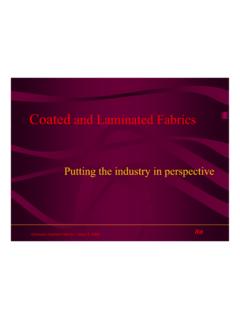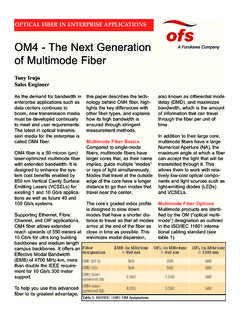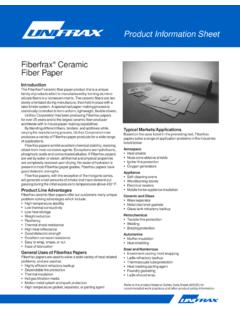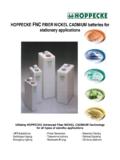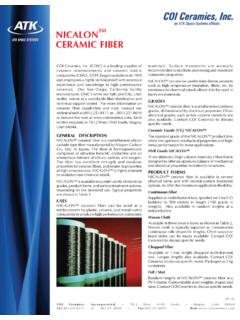Transcription of High Performance And High Temperature …
1 1 high Performance And high Temperature Resistant Fibers- Emphasis on Protective ClothingI. INTRODUCTION Faster, stronger, lighter, safer .. these demands are constantly being pushed upon today'sresearchers and manufacturers, including protective clothing - routine or specialized. high performanceand high Temperature resistant fibers aid enormously in allowing products to meet these challenges. Themarkets and products which are facilitated by the use of these fibers go far beyond the scope andawareness of most people. This paper intends to provide a solid overview of the definitions,properties, products and end uses associated with some of the most common high Performance andhigh Temperature resistant fibers used today.
2 It is stressed that not all high Performance materials exploring details these materials, it is important to define the parameters of highperformance and high Temperature resistant fibers. For this discussion, the latter is classified as asynthetic fiber with a continuous operating Temperature ranging from 3750 F to 6000 classification of high Performance is less rigid and can be broken down into varioussegments. Generally speaking, fibers are said to be either commodity or high fibers are typically used in a highly competitive price environment which translates intolarge scale high volume programs in order to compensate for the (often) low , high Performance fibers are driven by special technical functions that requirespecific physical properties unique to these fibers.
3 Some of the most prominent of these propertiesare: tensile strength, operating Temperature , limiting oxygen index and chemical resistance. Each fiberhas a unique combination of the above properties which allows it to fill a niche in the high performancefiber comparative purposes carbon, glass and high density polyethylene are also these fibers don't necessarily meet all of the requirements of the stated definitions, theycommonly compete in the high Performance market and should therefore be following presents some basic characteristics of each classification.
4 Commodity Fibers high Performance Fibers Volume Driven Technically Driven Price oriented Specialty oriented Large scale, line- Smaller batch-type type production production2II. BASIC PROPERTIEST ensile strength is often the determining factor in choosing a fiber for a specific need (see chart1). A major advantage of high strength fibers over steel, for example, is the superiorstrength-to-weight ratio that such fibers can offer.
5 Para-aramid fiber offers 6-8 times higher tensilestrength and over twice the modulus of steel, at only one-fifth the weight, but in applications wherestrength is not of paramount importance, other properties must be resistance often plays an integral role in the selection of a fiber. Heat degradesfibers at different rates depending on the fiber type, atmospheric conditions and time ofexposure. The key property for high Temperature resistant fibers is their continuous operatingtemperature. Fibers can survive exposure to temperatures above their continuous operatingtemperatures, but the high heat will begin to degrade the fiber.
6 This degradation has the effect ofreducing the tensile properties of the fiber and ultimately destroying its common mistake is to confuse Temperature resistance with flame retardant ability. Flameretardant ability is generally measured by the Limiting Oxygen Index. LOI, basically, is the amount ofoxygen needed in the atmosphere to support combustion. Fibers with a Limiting Oxygen Index (LOI)greater than 25 are said to be flame retardant, that is there must be at least 25% oxygen present in orderfor them to burn. The LOI of a fiber can be influenced by adding a flame retardant finish to the chemicals are either added to the polymer solution before extruding the fiber or added to the fiberduring the spinning (extrusion) process.
7 In addition, impregnating or topically treating the fiber or thefabric, flame retardant properties are often added directly to fabrics (such as FR treating cotton fabrics).Just as heat can degrade a fiber, chemical exposure, such as contact with acids or alkalis, canhave a similar effect. Some fibers, such as PTFE ( DuPont s Teflon), are extremely resistant tochemicals. Others lose strength and integrity quite rapidly depending on the type of chemical and thedegree of concentration of the chemical or FIBER FORMS AND PRODUCT FORMSF ibers are available in several different forms.
8 The most common forms used are:$ Staple Fiber filaments cut into specific lengths usually spun into yarn$ Chopped Fiber coarser, cut to specific, often short, lengths to add to mixture$ Monofilament a single (large) continuous filament yarn like fishing line$ Multifilament extruded continuously with many filaments in the basic forms of fiber are then further processed into one of four major converted converted forms can be categorized into four groups:$ Spun yarn ! Knitted fabri3 $ Woven fabric ! Nonwoven fabricMost are familiar with yarn, woven and knitted fabrics.
9 Nonwoven fabrics may be anotherstory. The most common types of nonwoven fabrics are based on bonding and manufacturingprocesses - are:$ Needlefelts the fibers are mechanically entangled with barbed needles$ Dry-laid chemical or thermal bond many different forms, including$ Direct formed - spunbond and melt-blown (may be further bonded or combined)$ Stitch Bond sewn bond$ Wet-laid paper making process$ Hydro-entangled (spunlace) water jet entangled mechanical bondMany of the fibers are used in very similar end uses, but based on differences of specificproperties, each fiber tends to find its own niche where it has an advantage over the PROPERTIES AND THEIR APPLICATIONSA.
10 Meta-aramid: Nomex (DuPont), TeijinConex , TeijinConex HT (Teijin)Perhaps the best known and most widely used of the aramid fibers (Nomex is familiar tomany), meta-aramids are best known for their combination of heat resistance and strength. Inaddition, meta-aramid fibers do not ignite, melt or drip; a major reason for their success in theFR apparel market. In comparison to commodity fibers, meta-aramids offer better long-termretention of mechanical properties at elevated temperatures . Meta-aramids have a relativelysoft hand and tend to process very similarly to conventional fibers, giving them a wide range ofconverted products.
